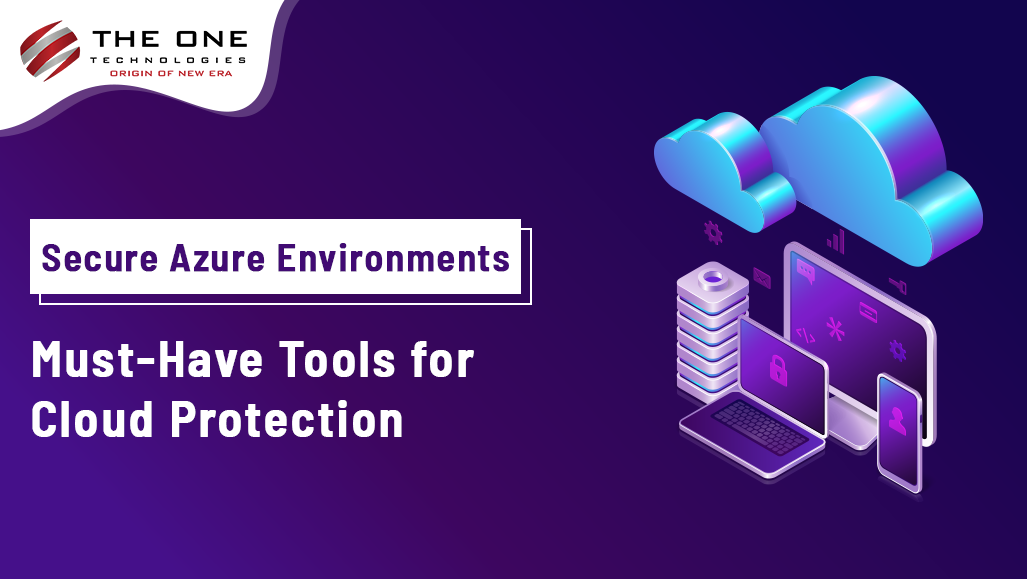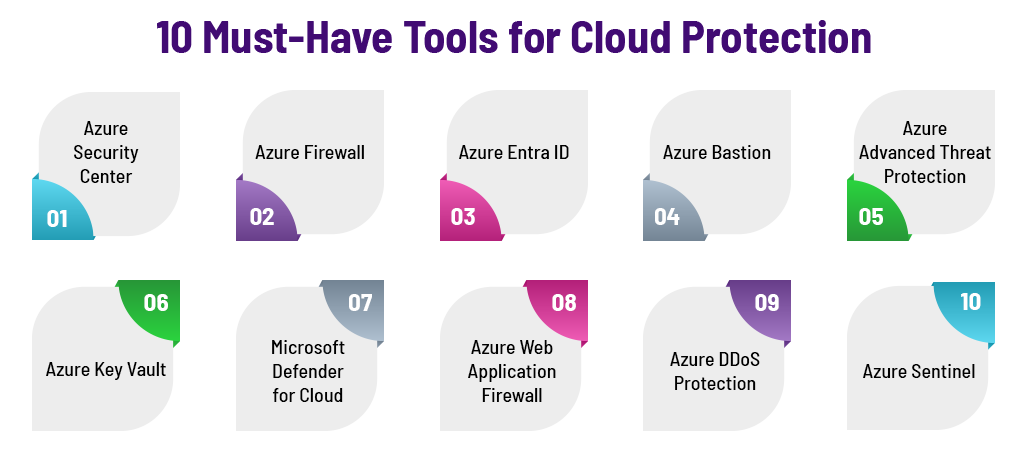Secure Azure Environments: Must-Have Tools for Cloud Protection

Introduction
Businesses are using cloud computing to improve flexibility, scalability, and operational efficiency in an era where digital transformation is crucial. Microsoft Azure is a top platform because of its extensive service portfolio and strong infrastructure. But as businesses move important tasks to the cloud, it's more important than ever to make sure strong security safeguards are in place.
Azure environment necessitates a proactive strategy that uses cutting-edge security tools with best practices. Its toolkit includes everything from data encryption and compliance monitoring to threat detection and identity management, is built to protect your infrastructure from ever-changing cyberattacks.
In this article, we explore the essential tools that each business using Azure must think about to safeguard their deployments. Knowing these platforms and their capabilities is essential to ensuring a safe and reliable cloud environment, regardless of experience level. Let's examine how these 10 excellent tools can successfully reduce the risks and protect your operations.
Table of Content
10 Must-Have Tools for Cloud Protection
Here are the 10 must-have tools for cloud protection, essential for safeguarding your data and ensuring robust security in the cloud. These tools provide comprehensive solutions to protect against threats, manage risks, and maintain compliance.

1. Azure Security Center
For hybrid cloud workloads, Azure Security Center offers threat protection and unified safety administration. It provides ongoing posture assessments along with security-enhancing recommendations. Its machine learning and behavioral analytics-based enhanced vulnerability detection capabilities allow it to seamlessly connect with other services to provide a safe solution.
Key Features:
- Enhanced threat protection and unified security management for workloads across hybrid clouds.
- Continuous assessment and safety recommendations.
- Advanced threat detection using behavioral analytics and machine learning.
- Integration with additional services to provide a thorough reliable strategy.
2. Azure Firewall
Azure Virtual Network resources are safeguarded by this tool, a managed cloud-based network solution. It provides unlimited cloud scalability and built-in high availability. This tool uses threat intelligence to detect and stop traffic from known malicious IP addresses through application and network-level filtering rules, providing strong protection for your cloud infrastructure.
Key Features:
- Threat intelligence-based filtering to alert and deny traffic from/to known malicious IP addresses.
- Filtering rules at the application and network levels.
- Unrestricted cloud scalability and built-in high availability.
- Cloud-based, managed network security service to safeguard Azure Virtual Network resources.
3. Azure Entra ID
An identity and access management solution called Azure Entra ID makes it easier to grant users and apps safe access. To improve security, it offers multi-factor authentication and single sign-on (SSO). It integrates with thousands of SaaS apps for seamless identity management, enabling access control based on user identity, location, and device with Conditional Access policies.
Key Features:
- Identity and access management for users and applications.
- Single sign-on (SSO) and multi-factor authentication (MFA).
- Conditional Access policies to manage access based on user, location, and device.
- Integration with thousands of SaaS applications for seamless identity management.
4. Azure Bastion
Virtual machines can be easily and securely accessed via SSH and RDP with Azure Bastion without being exposed to the public internet. As a fully managed PaaS, it offers improved reliability by doing away with the requirement for jump servers, making management easier while maintaining security and cost-effectiveness.
Key Features:
- Secure and seamless RDP and SSH access to virtual machines without public IP addresses.
- Fully managed PaaS that hardens remote access.
- Provides a more secure and cost-effective way to access your VMs.
- Simplified management without needing to manage and maintain jump servers.
5. Azure Advanced Threat Protection (now part of Microsoft Defender for Identity)
On-premises and cloud-based, Azure Advanced Threat Protection identifies unusual activity and advanced threats. It detects and investigates issues using built-in intelligence, connecting with other Microsoft security technologies for a unified safety approach. Strong security is maintained across the environment with thorough alerts and remedial suggestions.
Key Features:
- Detects advanced threats and suspicious activity on-premises and in the cloud.
- Uses built-in intelligence to identify and investigate advanced threat.
- Integrates with other Microsoft security tools for a unified approach.
- Provides detailed alerts and recommendations for remediation.
6. Azure Key Vault
Access to secrets, keys, and certificates is controlled and secured by Azure Key Vault. For automated management, it connects with services and provides HSM-backed key management for increased security. Ensuring compliance and governance while protecting sensitive data and applications is made possible by role-based access control and audit logging.
Key Features:
- Securely manage and control access to secrets, keys, and certificates.
- Integration with Azure services for automated key and secret management.
- HSM-backed key management for enhanced security.
- Role-based access control and audit logging for compliance and governance.
7. Microsoft Defender for Cloud
Effective threat protection is offered by Microsoft Defender for Cloud for hybrid, on-premises, and Azure environments. It regularly evaluates the reliability posture and provides practical advice. It combines Microsoft 365 Defender with advanced detection driven by AI and machine learning to provide an effective solution.
Key Features:
- Extensive threat protection across Azure, on-premises, and hybrid environments.
- Security posture management with continuous assessments and actionable recommendations.
- Advanced threat detection using AI and machine learning.
- Integration with Microsoft 365 Defender for holistic protection.
8. Azure Web Application Firewall
Web applications are shielded from typical risks like SQL injection and cross-site scripting by Azure Web Application Firewall (WAF). It provides centralized and adaptable rules so that security policies can be customized to meet unique requirements. Robust online application reliability is ensured by real-time monitoring and alerting, which assists in identifying and responding to irregularities in web traffic.
Key Features:
- Protects web applications from common threats and vulnerabilities, such as SQL injection and cross-site scripting.
- Centralized protection for your web applications in Azure.
- Customizable rules for tailored security policies.
- Real-time monitoring and alerting for web traffic anomalies.
9. Azure DDoS Protection
Distributed denial-of-service attacks are automatically detected and mitigated by Azure DDoS Protection. It provides extensive attack analytics and telemetry through adaptive tuning and always-on traffic monitoring. A unified picture of security throughout the cloud environment is ensured by integration with Azure Security Center, which keeps service availability intact even in the event of an attack.
Key Features:
- Automatic detection and mitigation of distributed denial-of-service (DDoS) attacks.
- Always-on traffic monitoring and adaptive tuning.
- Extensive attack analytics and telemetry.
- Integration with Azure Security Center for a unified assured view.
10. Azure Sentinel
It is a cloud-native solution for Security Orchestration, Automation, and Response (SOAR) and Security Information and Event Management (SIEM). It provides automated reaction capabilities and real-time threat detection. It improves threat risks and investigation with integrated AI and machine learning, offering a scalable and affordable solution. Integrating it with Azure and other programs gives you a complete secure posture, which makes it a vital tool for safeguarding cloud settings.
Key Features:
- Cloud-native Security Information and SIEM and Security Orchestration, Automation, and Response (SOAR) solution.
- Real-time threat detection and automated response.
- Built-in AI and machine learning for threat detection and investigation.
- Scalable and cost-effective, with integration across Azure and third-party solutions for an assured posture.
Wrapping Up
Azure environment protection is essential for safeguarding sensitive data, ensuring business continuity, and fostering customer trust, beyond mere compliance. The tools highlighted in this post serve as foundational pillars for establishing robust cloud defenses. Integrating capabilities such as threat detection, access management, encryption, and compliance solutions enhances resilience against cyber-attacks.
Staying abreast of evolving threats and evolving security measures is crucial in the dynamic cybersecurity landscape. Microsoft continually enhances its ecosystem with new features aimed at enhancing security, necessitating ongoing assessment and adaptation of security measures for sustained protection. Investing in robust security processes and tools enables organizations to maximize Azure's security capabilities while securing digital assets effectively. Embracing digital innovation confidently and mitigating risks in an interconnected world requires prioritizing cloud security.
Lastly, partnering with an IT outsourcing company ensures comprehensive protection through expert utilization of Azure tools. This can ensure proactive monitoring and tailored response strategies for safeguarding cloud infrastructure.
People Also Ask
Why is it important to secure Azure environments?
It is crucial because:
- Protects Sensitive Data: Ensures that your data is safe from unauthorized access and breaches.
- Maintains Compliance: Helps meet regulatory requirements and industry standards.
- Prevents Downtime: Protects against disruptions caused by cyber-attacks.
- Safeguards Reputation: Avoids the negative impact on your organization’s reputation from data breaches or security incidents.
- Cost Efficiency: Reduces potential financial losses due to security incidents and data breaches.
How do security tools in Azure enhance cloud protection?
Azure's solutions improve cloud security by offering real-time vulnerability and threat detection through continuous monitoring. By automating threat detection and response, they limit the impact of security incidents by promptly addressing and mitigating them. These tools guarantee that every facet of your cloud environment is safeguarded by providing all-inclusive security solutions that address a broad variety of requirements, from network security to identity and access control. Also, by regularly evaluating and enhancing your security procedures, they provide proactive security posture management, assisting you in staying ahead of possible attacks and weaknesses.
Why should organizations use Microsoft Defender for Cloud?
Because it offers effective threat protection along with detection and response capabilities. By regularly evaluating your surroundings and offering practical security recommendations to strengthen your defenses, it delivers security posture management. By assisting you in meeting regulatory and compliance obligations through detailed reporting and ongoing monitoring, Microsoft Defender for Cloud further enhances compliance by guaranteeing that your cloud environment complies with pertinent standards and is safe.
What are the risks of not securing your Azure environment?
Numerous threats can arise from not protecting your Azure environment, such as data breaches, in which unauthorized access to private data causes monetary loss and legal repercussions. DDoS attacks and other service disruptions can result in substantial downtime that impacts business operations and productivity. The financial impact of breaking regulatory standards might be exacerbated by fines and legal action. Strong security procedures are essential because the whole cost of recovering from a security incident, including cleanup costs and lost revenue, can be expensive.
How does Azure Security Center help in securing the environment?
With its single security view across all your resources and its centralized management, Azure Security Center contributes to environmental security. It ensures proactive threat detection and prevention by utilizing AI and advanced analytics to identify and address threats. Through ongoing evaluation and practical advice, the Security Center also helps with compliance tracking, ensuring that you adhere to a variety of regulations. You can also ensure that your environment is always being watched over, safeguarded against attacks, and complaints.










